Tous les moutons du monde
Belfaa, Souss-Massa-Drâa, Morocco
The sheep were gathered in little knots, shaggy-fleeced, looking mostly disgruntled, but clearly unaware of the enormity of what awaited them. Some of them had been lightly splashed on their heads with henna or dye, giving them a faintly punk appearance. Here and there, for the benefit of those unable to spring for a whole sheep, there were also clusters of goats. Buyers strolled among the animals, appraising them with a professional eye.
Eid al-Adha, the Festival of the Sacrifice, is something like the Muslim world's equivalent of Thanksgiving: the whole family comes over for dinner and the day is not complete unless the host provides a large roasted animal as the centerpiece of the meal. But whereas Americans can get away with a mere turkey, for Eid al-Adha nothing less than a quadruped will do. In some parts of the Muslim world, that means a cow; in Morocco, it's almost always a sheep or a goat. The unlucky creature is slaughtered and divided into three parts: one third for the family, a third for friends and neighbors, and the final third for the poor.
Moroccans may choose sheep over cows because the semi-arid climate of Morocco isn't really suitable for cattle-rearing, but sacrificing a sheep is also more in keeping with the origin of the festival. Eid al-Adha commemorates the moment when Abraham (Ibrahim in the Islamic world) was all set to sacrifice his son Isaac to please God. At the last moment, God – satisfied with Abraham's obedience – substituted a sheep, much to the relief of both Abraham and Isaac. What the sheep thought of the arrangement isn't recorded, but it probably wasn't happy.
The sheep at Belfaa Market weren't happy either, but the life of a sheep in Morocco probably isn't much fun at the best of times. Every animal there was destined for the table sooner or later; it just so happened that most of them would be reaching their destination very soon indeed.
Over the next few days, we saw a steady flow of sheep on their way to or from one market or another. Some were gathered in groups, in the back of pickups or carts, obviously on their way to be sold. Others traveled singly – slung across someone's shoulders, or wheeled in little hand-carts, or balanced precariously on a motorcycle, legs sticking out into traffic, bleating inaudible protests at the indignity of it all.
